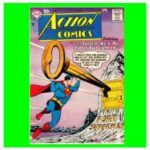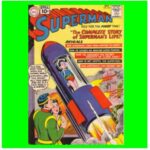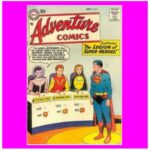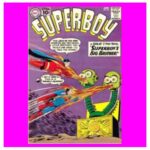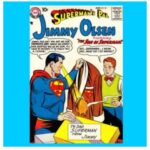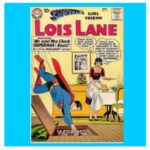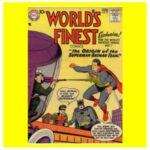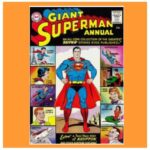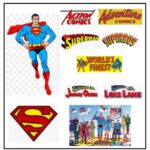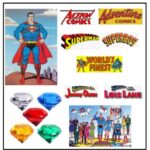Clicking on the following links or images will take you to the different Silver-Age Superman comic collections covered in this section:
Of all the comics I read during my childhood, the ones that gave me the most joy were the Silver-Age Superman family of comics. That is why I have made an effort to collect each and every Superman comic from this era in the various lists in this section. During the Silver Age, there were altogether seven comic-book titles featuring Superman (Action Comics, Adventure Comics, Jimmy Olsen, Lois Lane, Superboy, Superman and World’s Finest), not to mention the multiple Annuals and Giants (most of them 80 pages long) that were published on a regular basis with a selection of reprinted stories from the Golden Age or the early Silver Age.
The mythology of Superman stories created during this era was as grand as any epic such as the Ramayana or Mahabharata. More than anyone else, the person responsible for creating this amazing mythology was Mort Weisinger, who assumed the editorship of all the Superman titles in the late 1950s. During his tenure, Weisinger assembled an incredible team of writers and artists who gave life to his vision of Superman as a three-dimensional human being rather than the cardboard-cutout character he was depicted as during most of the Golden Age.
The three main Superman writers during most of the Silver Age were Jerry Siegel, Otto Binder and Edmond Hamilton; other notable Superman writers during this period were Bill Finger, Jerry Coleman and Leo Dorfman. All of them wrote great stories, but of these my two favorites are Jerry Siegel and Edmond Hamilton. As the co-creator of Superman, Jerry Siegel had already established his name in history, but in addition he was second only to Mort Weisinger in creating the mythology of Superman’s Silver Age. He was a prolific writer who scripted many beautiful human-interest stories. Edmond Hamilton was an accomplished science-fiction author who brought his amazing skills to the art of comic-book writing. He specialized in scripting heroic tales of wonder, often in the form of imaginary stories or 3-part novels.
In the latter half of the Silver Age, some new talented writers entered the scene, most notably Jim Shooter and Cary Bates. Jim Shooter was a child prodigy in the comics world who started scripting many amazing stories (even sketching layouts for the artwork!) at the tender age of 13! It was Mort Weisinger who recognized Jim Shooter’s genius and offered him a job as a regular writer on various Superman titles, especially on stories featuring the Legion of Super-Heroes in Adventure Comics.
Three artists who had established themselves in the Golden Age continued to shine during the Silver Age as well: Wayne Boring, Al Plastino and Curt Swan. They each played a role in transforming Superman into a more modern super-hero from the cartoonish-looking character he used to be in the Golden Age comics. Of these three, the definitive Superman artist was Curt Swan, whom I consider the greatest Superman illustrator of all time. He was a superlative artist whose depiction of Superman was more heroic and noble than any other artist’s, before or since. While the other two artists usually pencilled and inked their stories, Curt Swan was mostly a penciller. In addition to pencilling many superb Superman stories, he also pencilled the vast majority of covers for the entire family of Superman comics during the Silver Age, with the able assistance of inkers Stan Kaye, George Klein and Sheldon Moldoff.
There were also other great Superman artists in the Silver Age who specialized in specific comic-book titles or characters, notably Kurt Schaffenberger (Lois Lane), George Papp (Superboy), Jim Mooney (Supergirl) and John Forte (Legion of Super-Heroes). Incidentally, Curt Swan was also a regular artist on the Jimmy Olsen stories (again with the collaboration of various inkers). In the late 1960s, near the end of the Silver Age, several new artists entered the scene, including Neal Adams, Murphy Anderson, Ross Andru and Mike Esposito. The most remarkable of these was Neal Adams, whose covers were simply stunning and guaranteed to arrest your attention. (Although Neal Adams mostly drew covers and did not draw many stories on the Superman titles, he became a regular, highly lauded, story artist for other DC characters such as Batman and Green Lantern.)
Under the stewardship of Mort Wesinger, an incredible number of plot innovations were introduced to build the Superman legend, including: the Fortress of Solitude, Brainiac, the Bottle City of Kandor, Supergirl, the Phantom Zone, Lori Lemaris (and many other ‘LL’ ladies), Superman robots, Bizarro, Lex Luthor’s backstory, the planet Lexor, the Legion of Super-Heroes, Krypto and other super-pets, and the Virus X storyline. For the first time, a serious attempt was made to develop consistency and continuity in a comic-book character’s history. Added to the mix were imaginary stories, 3-part novels (full-length comic stories) and giant collections of reprinted stories from the past.
These changes produced a much tighter, more fan-oriented, version of the Superman mythology. The addition of letters pages prompted readers to provide feedback and ask questions such as: What is the scientific explanation for Superman’s powers? Because Earth’s lesser gravity did not seem sufficient to explain all of Superman’s powers, an additional explanation was presented: the radiation from Earth’s yellow sun (in contrast to Krypton’s red sun). Superman’s muscular powers, super strength, speed, and flight were attributed to gravity, while his super senses and invulnerability were attributed to the yellow sun. This also meant that Superman lost his super powers under a red sun (or, for that matter, a sun of any color other than yellow), which led to many interesting plots where Superman visited various other worlds with a red sun and he had to survive by his wits rather than by using his powers.

